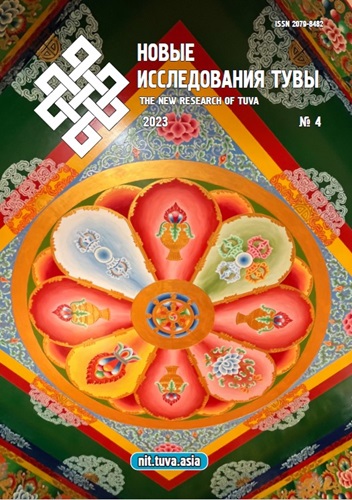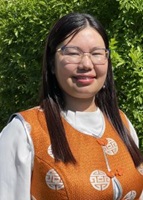Linguoculturological description of the spatial code of culture (based on the material of the Russian and Tuvan languages)
DOI:
https://doi.org/10.25178/nit.2023.4.11Keywords:
linguoculturology; spatial code of culture; Russian language; Tuvan language; phraseological unit; proverbAbstract
The article delves into a specific segment of the linguistic worldview shared by the Russian and Tuvan ethnic groups. This exploration centers on the analysis of phraseological and paremiological units that are intricately linked to the concept of space. The study meticulously discerns the distinct mental frameworks and perceptual paradigms prevalent in these ethnic groups. This discernment is facilitated through a meticulous examination of these linguistic units, viewed as symbolic representations embedded within the cultural language. The research endeavor is focused on unearthing culturally significant meanings inherent in the semantics of the scrutinized units, while taking into account their nuanced figurative connotations.
The linguocultural analysis of the examined linguistic code is constructed upon the identification of culturally significant information. This involves establishing correlations between the spatial code and the broader cultural code. The study meticulously dissects the mechanisms, resemblances, and disparities underpinning the formation and operation of this specific cultural code.
Emphasis is placed on exploring semantic oppositions, or models, such as own/foreign, up/down, and near/far. These oppositions, which prove to be universal across both languages, harbor diverse potentials in the linguocultural and figurative representation of spatial relationships.
References
Berdiaev, N. A. (2007) Sud'ba Rossii [The Fate of Russia]. Moscow, EKSMO. 251 p. (In Russ.).
Vaisgerber, I. L. (2004) Rodnoi iazyk i formirovanie dukkha [Native language and the formation of the spirit]. Moscow, URSS. 229 p. (In Russ.).
Gumbol'dt, V. fon. (1984) Izbrannye trudy po iazykoznaniiu [Selected works on linguistics]. Moscow, Progress. 451 p. (In Russ.).
Ermakova, O. P. (2000) Prostranstvennye metafory v russkom iazyke [Spatial metaphors in Russian]. In: Logicheskii analiz iazyka: Iazyki prostranstv [Logical analysis of language: Languages of spaces] / ed. by N. D. Arutiunova and I. B. Levontina. Moscow, Yazyki russkoi kul'tury. 448 p. Pp. 289–299. (In Russ.).
Zakharenko, I. V. (2013) Arkhetipicheskaia oppozitsiia «svoi — chuzhoi» v prostranstvennom kode kul'tury [Archetypal opposition of “friend and foe” in the spatial code of culture]. In: Yazyk, soznanie, kommunikatsiia [Language, consciousness, communication]: collection of articles / editorial board: M. L. Kovshova et al. Moscow, MAKS Press. 144 p. Pp. 15–31. (In Russ.).
Izotova, N. N. (2020) Kul'turnyi kod: semioticheskii aspekt [Cultural code: semiotic aspect]. In: Culture and Civilization, vol. 10, no. 1, pp. 122–127. (In Russ.). DOI: https://doi.org/10.34670/AR.2020.47.1.016
Kenin-Lopsan, M. B. (2006) Traditsionnaia kul'tura tuvintsev [Traditional culture of Tuvans]. Kyzyl, Tuvan Book Publisher. 232 p. (In Russ.).
Krasnykh, V. V. (2003) «Svoi» sredi «chuzhikh»: mif ili real'nost'? [“One's own” among “strangers”: myth or reality?]. Moscow, ITDGK «Gnozis». 375 p. (In Russ.).
Kuzhuget, Sh. Iu., Suvandii, N. D., Dambaa, Sh. V., Lamazhaa, Ch. K. (2019) Kontsept törel ‘rodstvennik’ v iazykovoi kartine mira tuvintsev [The concept of törel (‘relative’) in the Tuvan linguistic world picture]. New Research of Tuva, no. 3, pp. 149–157. (In Russ.). DOI: https://doi.org/10.25178/nit.2019.3.12
Kuzhuget, Sh. Yu. (2023) Otnoshenie tuvintsev k zemle v tuvinskoi literature XX–XXI vv. [Tuvans’ attitude towards the earth in the Tuvan literature of the 20th–21st centuries]. New Research of Tuva, no. 1, pp. 64–79. (In Russ.). DOI: https://doi.org/10.25178/nit.2023.1.4
Lakoff, G. and Johnsen, M. (2004) Metafory, kotorymi my zhivem [Metaphors we live by]. Moscow, Editorial URSS. 256 p. (In Russ.).
Lamazhaa, Ch. K. (2021a) Sotsial'naia kul'tura tuvintsev i onlain-prostranstvo [Social Culture of Tuvans and Online Space]. New Research of Tuva, no. 2, pp. 115–129. (In Russ.). DOI: https://doi.org/10.25178/nit.2021.2.10
Lamazhaa, Ch. K. (2021b) Osnovnye problemy issledovaniia rodstva i rodstvennykh grupp sovremennykh tuvintsev: pasportizatsiia, terminologiia i podderzhanie rodstva [The Main Issues of the Study of Kinship and Kin Groups of Contemporary Tuvans: Passportization, Terminology and Maintenance of Kinship]. New Research of Tuva, no. 4, pp. 6–21. (In Russ.). DOI: https://doi.org/10.25178/nit.2021.4.1
Lamazhaa, Ch. K. (2023) Concepts of Culture: Form, idea, social regulation [Kontsepty kul’tury: forma, ideia, sotsial’naia reguliatsiia]. New Research of Tuva, no. 1, pp. 6–25. (In Russ.). DOI: https://doi.org/10.25178/nit.2023.1.1
Logicheskii analiz iazyka. Iazyki prostranstv [Logical analysis of the language. Languages of spaces] (2000) / ed. by N. D. Arutiunova and I. B. Levontina. Moscow, Yazyki russkoi kul'tury. 448 p. (In Russ.).
Lotman, Yu. M. (1996) Vnutri mysliashchikh mirov [Inside the Thinking Worlds]. Moscow, Yazyki russkoi kul'tury. 464 p. (In Russ.).
Mainy, Sh. B. (2023) Predstavleniia o cher ‘zemle’ sovremennykh tuvintsev [Perceptions of ‘cher’ (‘earth’) among contemporary Tuvans]. New Research of Tuva, no. 1, pp. 38-63. (In Russ.). DOI: https://doi.org/10.25178/nit.2023.1.3
Nikogosian, A. A. and Fatkullina, F. G. (2022) Teoreticheskie problemy izucheniia i klassifikatsii kul'turnykh kodov v sovremennom iazykoznanii [Theoretical problems of studying and classification of cultural codes in modern language]. Vestnik Bashkirskogo universiteta, vol. 27, no. 3, pp. 661–664. (In Russ.).
Ondar, V. S. (2016) Otrazhenie kategorii prostranstva v tuvinskom iazyke (na materiale geroicheskogo eposa «Boktu-Kirish, Bora-Sheelei») [Reflection of the category of space in the Tuvan language: the case of the “Boktu-Kirish, Bora-Sheelei” heroic epic]. Filologicheskie nauki. Voprosy teorii i praktiki, no. 2 (56) : in 2 parts. Part 2, pp. 129–134. (In Russ.).
Oorzhak, B. Ch. and Khertek, A. B. (2016) Vyrazhenie kategorii prostranstva i vremeni v tuvinskom iazyke [Expression of the categories of space and time in the Tuvan language]. Mir nauki, kul'tury i obrazovaniia, no. 1(65), pp. 276–279. (In Russ.).
Öövüs. Vozvrashchenie tuvinskoi iurty [Oovus. Return of the Tuvan yurt] (2022) / ed. by Ch. K. Lamazhaa and N. D. Suvandii. Kyzyl, s. n. 85 p. (In Russ.).
Popkov, Yu. V. and Tiugashev, E. A. (2019) Prostranstvennyi obraz Tuvy v ob"ektive sotsiokul'turnoi fenomenologii [The spatial image of Tuva in the focus of sociocultural phenomenology]. New Research of Tuva, no. 3, pp. 4–14. (In Russ.). DOI: https://doi.org/10.25178/nit.2019.3.1
Porechnaia, V. I. (2021) Prostranstvennyi kod kul'tury kak lingvokul'turnoe poniatie [Spatial culture code as a linguocultural concept]. Baltiiskii gumanitarnyi zhurnal, vol. 10, no. 4(37), pp. 317–321. (In Russ.).
Potebnia, A. A. (1999) Mysl' i iazyk [Thought and language]. Moscow, Labirint. 300 p. (In Russ.).
Samdan, Z. B. (2018) Simvolika vremeni i prostranstva v tuvinskoi mifologii [Symbolism of time and space in tuvan mythology]. Mir nauki, kul'tury, obrazovaniia, no. 6 (73), pp. 501–504. (In Russ.).
Samigullina, A. S. (2007) Prostranstvennyi kod kul'tury i ego smyslovye proektsii [The spatial code of culture and its semantic projections]. Vestnik Cheliabinskogo gosudarstvennogo universiteta. Ser. Filologiia. Iskusstvovedenie, no. 1, pp. 82–87. (In Russ.).
Sanchay, Ch. Kh. (2023) Obrazy rodnoi zemli v muzykal’no-pesennoi kul’ture tuvintsev [Images of the native land in the musical and song culture of the Tuvans]. New Research of Tuva, no. 1, pp. 80–109. (In Russ.). DOI: https://doi.org/10.25178/nit.2023.1.5
Sepir E. (1993) Izbrannye trudy po iazykoznaniiu i kul'turologii [Selected works on linguistics and cultural studies]: transl. from Engl., ed. by A. E. Kibrik. Moscow, Izdatel'skaia gruppa «Progress»; Univers. 656 p. (In Russ.).
Simbirtseva, N. A. (2016) «Kod kul'tury» kak kul'turologicheskaia kategoriia [‘Culture code’ as a category of culturology]. Znanie. Ponimanie. Umenie, no. 1, pp. 157–167. (In Russ.). DOI: http://dx.doi.org/10.17805/zpu.2016.1.12
Suvandii, N. D. (2023) Cher ‘zemlia’ v paremiiakh tuvintsev [Cher ‘earth’ in Tuvan paroemias]. New Research of Tuva, no. 1, pp. 26–37. (In Russ.). DOI: https://doi.org/10.25178/nit.2023.1.2
Suzukei, V. Yu. (2009) Prostranstvo i vremia v traditsionnoi kul'ture tuvintsev [Space and time in traditional Tuvan culture]. New Research of Tuva, no. 1–2, pp. 250–267. (In Russ.).
Teliia, V. N. (1999) Pervoocherednye zadachi i metodologicheskie problemy issledovaniia frazeologicheskogo sostava iazyka v kontekste kul'tury [Priority tasks and methodological problems of the study of the phraseological composition of the language in the context of culture]. In: Frazeologiia v kontekste kul'tury [Phraseology in the context of culture] / ed. by V. N. Teliia. Moscow, Yazyki russkoi kul'tury. 336 p. Pp. 13–24. (In Russ.).
Tolstoi, N. I. (1995) Yazyk i narodnaia kul'tura: Ocherki po slavianskoi mifologii i etnolingvistike [Language and Folk Culture: Essays on Slavic mythology and Ethnolinguistics]. 2nd ed. Moscow, Indrik. 512 p. (In Russ.).
Traditsionnoe mirovozzrenie tiurkov Iuzhnoi Sibiri. Prostranstvo i vremia. Veshchnyi mir [The traditional worldview of Turkic peoples of South Siberia. Space and time. The outer world] (1988) / ed. by L'vova E. L., Oktiabr'skaia I. V., Sagalaev A. M. and Usmanova M. S. Novosibirsk, Nauka. 226 p. (In Russ.).
Chistik, Zh. K. (2010) Ekologicheskaia kul'tura tuvinskogo etnosa [Ecological culture of the Tuvan ethnic group] / ed. by S. S. Kurbatskaia. Kyzyl, Tuvan Book Publishing House. 176 p. (In Russ.).
Khayrullina, R., Saghitova, A., Fatkullina, F., Morozkina, E., Suleimanova, A., Vorobev, V. V. (2017) Language Personality in the Bilingual Context of the National Linguistic World Pictures // Man in India. Vol. 97 (14). P. 17–26.
Sakaeva, L., Yahin, M., Bagautdinova, G., Fatkullina, F. and Kenzhetayeva, G. (2017) The history of studying of phraseological units in English, Russian and Kumyk. Revista QUID. Special Issue, pp. 680–684.
Whorf, D. L. (1941) The Relation of Habitual Thought and Behavior to Language. Sapir Memorial Publication Fund Menasha, Wisconsin, USA. 92 p.
Published
How to Cite
For citation:
Vorobyev V. V., Fatkullina F. G. and Kuzhuget Sh. Yu. Lingvokul’turologicheskoe opisanie prostranstvennogo koda kul’tury (na materiale russkogo i tuvinskogo iazykov) [Linguoculturological description of the spatial code of culture (based on the material of the Russian and Tuvan languages)]. New Research of Tuva, 2023, no. 4, pp. 153-170. DOI: https://doi.org/10.25178/nit.2023.4.11
Issue
Section

This work is licensed under a Creative Commons Attribution-NonCommercial 4.0 International License.

Author(s) license holder(s) grant rights for their work to the journal (grantee of a license) under the simple non-exclusive open license in accordance with Art. 1286.1 «Open license for a research work, work of literature or fine arts», Civil Code of the Russian Federation.
New Research of Tuva publishes articles under the Creative Commons Attribution-NonCommercial license (CC BY-NC).
Since it is an open license, author(s) reserve the right to upload the article to their institutional repository, submit it to another journal (if it allows republications), or republish it on their own website (in full, or in part).
However, several conditions apply here:
a) The republished version must always contain the name(s) and affiliation(s) of the author(s), the original title and the hyperlink to the original version on the New Research of Tuva website;
b) It must be in open access, free of charge, and no category of readers must be in any way whatsoever advantaged over general readership.
c) should the contribution be submitted elsewhere by its author(s) without substantial modification (30% or more of original text unchanged), the body of the article should contain a disclaimer that the original version was published in New Research of Tuva (with a link to the respective page)
The CC-BY-NC is a non-revocable license which applies worldwide and lasts for the duration of the work’s copyright.











